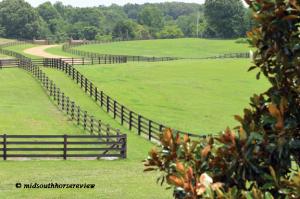Articles & Photos by Nancy Brannon
We sometimes use the phrase “greener pastures” as a euphemism for a better or more promising place, situation, etc. But the term literally means bright green, lush grass for our horses, cattle, and other grazing animals, as well as a better place for grazing. The spring rains and sunshine have led to abundant growth in grasses and legumes in the mid-south, giving our horses nutritious and sumptuous forage.
While photographing dressage horses and riders at the Mid-South Dressage Academy Summer Solstice show in June, I had the opportunity to get a “lofty” view of some of Elizabeth Clifton’s expansive pastures and paddocks. Enjoy the view!
The UT Extension Service publication, “Pastures for Horses,” by Gary Bates, states:
“Properly managed pastures can provide much of the feed needed by horses, while providing the most natural and healthy environment for exercise and rest. For most classes of horse, a well-managed pasture can provide all of the nutrients needed by the animal. For horses with elevated nutrient requirements (i.e., growth, reproduction, exercise), pasture should be an important part of their nutritional program. Productive pastures can provide an inexpensive, high-quality portion of the horse diet…
“In order for a pasture to provide a majority of the diet, approximately two to three acres are needed for each mature horse (1000-1200 lbs).”
Read the Pastures For Horses at: https://extension.tennessee.edu/publications/Documents/PB1651.pdf
Barn Swallows
Do you have Barn Swallows in your barn? If so, you have a natural insect controller on the premises. It is one of the most familiar birds in rural areas and semi-open country. They have adopted humans as neighbors, typically placing their nest in barns or garages, or under bridges or wharves. Their nests are a cup of mud and dried grass, lined with feathers.
Barn Swallows feed on a wide variety of flying insects, especially flies (including house flies and horse flies), beetles, wasps, wild bees, winged ants, and true bugs. They also eat some moths, damselflies, grasshoppers, and other insects, and a few spiders and snails. Only occasionally do they eat a few berries or seeds.
Barn Swallows feed on the wing, snagging insects from just above the ground or water to heights of 100 feet or more. They fly with fluid wingbeats in bursts of straight flight, rarely gliding, and can execute quick, tight turns and dives. When aquatic insects hatch, Barn Swallows may join other swallow species in mixed foraging flocks.
You can find the adaptable Barn Swallow feeding in open habitats from fields, parks, and roadway edges to marshes, meadows, ponds, and coastal waters. Their nests are often easy to spot under the eaves or inside of sheds, barns, bridges and other structures.
Sources:
Barn Swallow. All About Birds. The Cornell Lab of Ornithology. https://www.allaboutbirds.org/
Barn Swallow. Guide to North American Birds. Audubon. www.audubon.org
We sometimes use the phrase “greener pastures” as a euphemism for a better or more promising place, situation, etc. But the term literally means bright green, lush grass for our horses, cattle, and other grazing animals, as well as a better place for grazing. The spring rains and sunshine have led to abundant growth in grasses and legumes in the mid-south, giving our horses nutritious and sumptuous forage.
While photographing dressage horses and riders at the Mid-South Dressage Academy Summer Solstice show in June, I had the opportunity to get a “lofty” view of some of Elizabeth Clifton’s expansive pastures and paddocks. Enjoy the view!
The UT Extension Service publication, “Pastures for Horses,” by Gary Bates, states:
“Properly managed pastures can provide much of the feed needed by horses, while providing the most natural and healthy environment for exercise and rest. For most classes of horse, a well-managed pasture can provide all of the nutrients needed by the animal. For horses with elevated nutrient requirements (i.e., growth, reproduction, exercise), pasture should be an important part of their nutritional program. Productive pastures can provide an inexpensive, high-quality portion of the horse diet…
“In order for a pasture to provide a majority of the diet, approximately two to three acres are needed for each mature horse (1000-1200 lbs).”
Read the Pastures For Horses at: https://extension.tennessee.edu/publications/Documents/PB1651.pdf
Barn Swallows
Do you have Barn Swallows in your barn? If so, you have a natural insect controller on the premises. It is one of the most familiar birds in rural areas and semi-open country. They have adopted humans as neighbors, typically placing their nest in barns or garages, or under bridges or wharves. Their nests are a cup of mud and dried grass, lined with feathers.
Barn Swallows feed on a wide variety of flying insects, especially flies (including house flies and horse flies), beetles, wasps, wild bees, winged ants, and true bugs. They also eat some moths, damselflies, grasshoppers, and other insects, and a few spiders and snails. Only occasionally do they eat a few berries or seeds.
Barn Swallows feed on the wing, snagging insects from just above the ground or water to heights of 100 feet or more. They fly with fluid wingbeats in bursts of straight flight, rarely gliding, and can execute quick, tight turns and dives. When aquatic insects hatch, Barn Swallows may join other swallow species in mixed foraging flocks.
You can find the adaptable Barn Swallow feeding in open habitats from fields, parks, and roadway edges to marshes, meadows, ponds, and coastal waters. Their nests are often easy to spot under the eaves or inside of sheds, barns, bridges and other structures.
Sources:
Barn Swallow. All About Birds. The Cornell Lab of Ornithology. https://www.allaboutbirds.org/
Barn Swallow. Guide to North American Birds. Audubon. www.audubon.org









